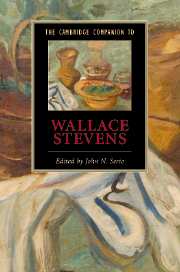Book contents
- Frontmatter
- Introduction
- 1 Wallace Stevens: A Likeness
- 2 Stevens and Harmonium
- 3 Stevens in the 1930s
- 4 Stevens and the supreme fiction
- 5 Stevens’ late poetry
- 6 Stevens and his contemporaries
- 7 Stevens and romanticism
- 8 Stevens and philosophy
- 9 Stevens’ seasonal cycles
- 10 Stevens and the lyric speaker
- 11 Stevens and linguistic structure
- 12 Stevens and painting
- 13 Stevens and the feminine
- 14 Stevens and belief
- Further reading
- Index
12 - Stevens and painting
Published online by Cambridge University Press: 28 May 2007
- Frontmatter
- Introduction
- 1 Wallace Stevens: A Likeness
- 2 Stevens and Harmonium
- 3 Stevens in the 1930s
- 4 Stevens and the supreme fiction
- 5 Stevens’ late poetry
- 6 Stevens and his contemporaries
- 7 Stevens and romanticism
- 8 Stevens and philosophy
- 9 Stevens’ seasonal cycles
- 10 Stevens and the lyric speaker
- 11 Stevens and linguistic structure
- 12 Stevens and painting
- 13 Stevens and the feminine
- 14 Stevens and belief
- Further reading
- Index
Summary
Migratory passings to and fro
Wallace Stevens felt profoundly the need for the arts in a time of faltering faiths. In his 1951 lecture at the Museum of Modern Art in New York, he says: “The paramount relation between poetry and painting today, between modern man and modern art is simply this: that in an age in which disbelief is so profoundly prevalent or, if not disbelief, indifference to questions of belief, poetry and painting, and the arts in general, are, in their measure, a compensation for what has been lost” (748). The arts preserve and renew our humanity by bringing feeling to experience and by creating a record of “what we felt / At what we saw” (128). They offer a form of resistance to contemporary upheaval, not an escape, but a way of collecting ourselves and pressing back with expressive orders. Painting in particular - with its direct appeal to the eye and its palpable being in the world, with its visible history of orders formed and reformed - embodied Stevens' sense of this project: to confirm our humanity through imaginative response to reality. Throughout his career Stevens contemplated the relation between poetry and painting; he saw in this relation not only a common artistic aim, but also a paradigm for an ultimate relation: “The world about us would be desolate except for the world within us. There is the same interchange between these two worlds that there is between one art and another, migratory passings to and fro, quickenings, Promethean liberations and discoveries” (747).
- Type
- Chapter
- Information
- The Cambridge Companion to Wallace Stevens , pp. 164 - 179Publisher: Cambridge University PressPrint publication year: 2007
- 2
- Cited by

